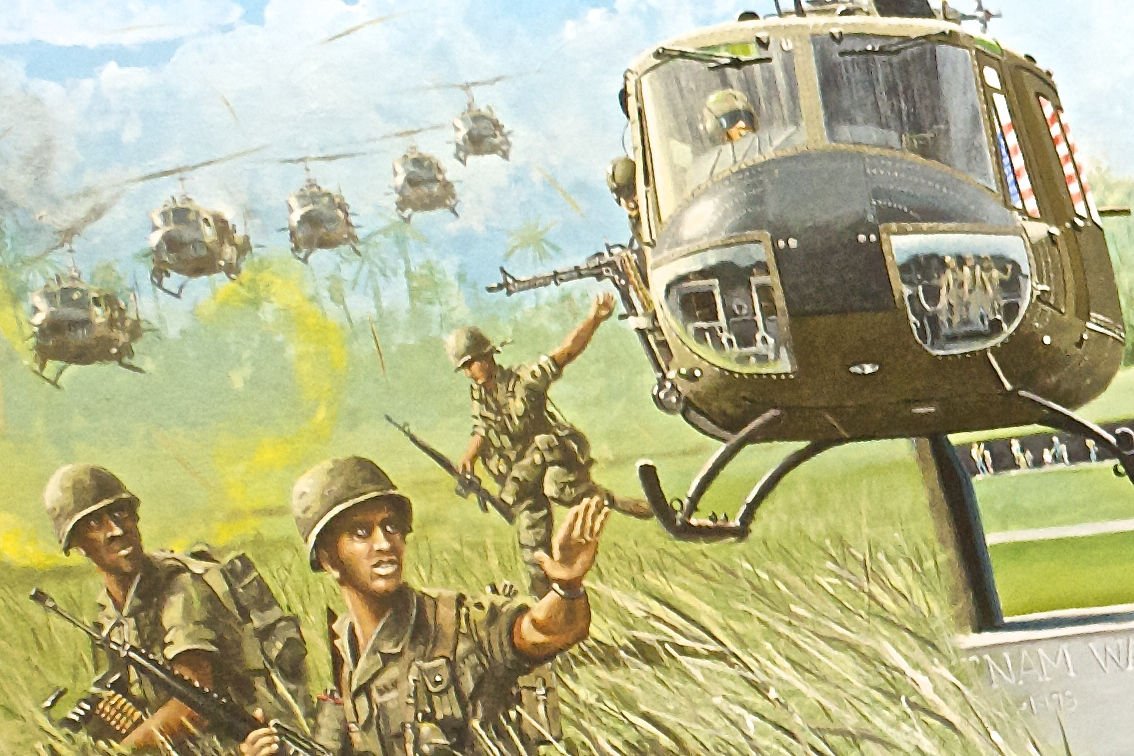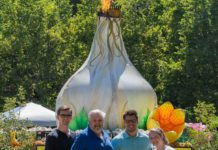
GILROY—In Gilroy aviation artist Joe Kline’s latest work, at the end of the muzzle of the M60-7.62mm machine gun in the hovering Huey helicopter, there’s a just visible soldier manning the weapon to cover GIs in a landing zone in Vietnam.
It’s Kline. That’s what he did as a young kid back then over there.
His painting, called “Almost Home,” shows a scene from the Vietnam War juxtaposed to a contemporary scene that depicts three Gilroy veterans, Charles Richburg, Bob Johnston and Joe Garcia.
The trio is posed the same way as GIs in “The Three Soldiers,” the bronze statue by Frederick Hart on the National Mall in Washignton, DC that commemorates the Vietnam War.
Commissioned to mark the 50th Anniversary of the first deployment of American troops in Vietnam – U.S. Marines on March 8, 1965—it could just as easily commemorate for some the 40th Anniversary of the fall of Saigon on April 30, 1975, which ended a decade of war that tore the country’s fabric and killed more than 58,000 Americans—including 11 from Gilroy.
“My whole life is right there, the past and the present,” said Garcia, a former heavy construction equipment operator with a service connected disability and retirement.
Garcia served in Vietnam from November 1968 till January 1970, a period he says “seemed like forever.”
Initially assigned to artillery duty, he then joined the 1st Infantry LRRPs—the acronym for Long Range Recon Patrol and later called Rangers. They were the small groups of soldiers sent deep into enemy territory, often making contact or running into booby traps.
Garcia’s time in war still is with him and still he wonders what it was all about.
“To this day I don’t understand the purpose, why we went there, I don’t know. But what I do know is that at the time I did the right thing, I obeyed the law of the land,” he said.
“I was just trying to make it back home, and I know I helped other guys make it back home. I am a proud combat veteran.”
Richburg’s experience was on the other end of the world, at Ft. Gordon, Georgia, during the war. As an Army lieutenant just graduated from the ROTC program at Tuskegee Institute in Alabama, Richburg was assigned from 1972 to 1974 to administrative finance duties that included working with troops returning from war, many hospitalized by their terrible wounds.
“It was very traumatic, dealing with people who had been away from society but who still needed support,” Richburg said. “I was very touched by that, it’s one of the highlights of my career.”
Richburg went on to a 30-year career with IBM and now is retired. In Kline’s painting, he is the man on the left in the contemporary scene, holding a cane, which represents the M16A1 rifle held in the statue.
The cane, he says, is ironic because while he does not use a cane, his father, a WWII veteran, did.
As for Kline’s feeling about the end of the War in 1975, he said, “As many Vietnam Veterans say with pride, “We were winning when I left.” In my case that was early 1971. When I saw the country fall to the communists in 1975, after breaking multiple provisions in the cease fire that was signed in 1973, I was heartsick. I felt totally betrayed by the U.S. Government and the abandonment of our South Vietnamese allies. I hold those gutless politicians responsible for this outcome. Squandering all of those lives and sacrifice was, and still is, sickening to me. I can honestly say that I was more hurt by that outcome than anything that I saw during the war itself. Unfortunately, I see that history repeating itself now.”
Kline said that in the painting he tried to capture the “love of country, brotherhood, camaraderie and pride of service felt by and among Vietnam Veterans.
“I am extremely proud of my service and all those that I served with,” he said. “I would do it again, even knowing the outcome.”
Kline’s use of the cane is just one of the symbols in the generations-spanning painting. Others include flags of all branches of the service, the black and white MIA-POW flag representing still missing soldiers and a solider in war reaching out towards the veterans. Elephant grass, another symbol, flows from the landing zone to the peacetime scene, the Vietnam Wall is in the background, and there’s the split use of the Huey helicopter—as war machine on the left, a war memorial being touched by children in the contemporary scene.
The choice of the Gilroy vets to use in the photo was purposeful, according Kline, representing as it does the contributions by ethnic groups to the war effort; Garcia is Hispanic, Richburg is African-American and Johnston, in the middle, is Caucasian.
Kline calls the work “a symbolic representation of the Vietnam veterans’ service to the country.”
Even the limited number of prints to be made, 2,546, is symbolic; one for each serviceman still listed as missing in action.
Kline, a Huey helicopter crew chief with the Army’s 101st Airborne Division during the war, works for the city of Gilroy, as it’s Public Information Officer. His aviation art is considered among the best for its attention to detail and accuracy.
One of his works depicts former Gilroy Mayor Mike Gilroy and his pilot ejecting from their plane after it’s hit by enemy fire during the war. Kline was a pallbearer during Gilroy’s funeral in 2013.
Johnston called Kline, “an incredible artist, he ranks as a master. He caught it all (in the painting), I am just honored to be associated with it.”
Johnston served two terms in the Vietnam War beginning in 1969 and was wounded in the first tour with the 25th Infantry Division, which took more casualties—dead, wounded and missing—than any other outfit. After being reassigned to Germany, he said, he returned to Vietnam and the 101st Airborne Division because army life serving away from war did not appeal to him after being in combat.
“It was some of the best times of my life and some of the worst,” he said. “There is a sense of pride for having done a good job, as much as we were allowed to do, and a senses of remorse for all those that died trying to do what they were sent to do.”
After the war, Johnston ended up working again for the federal government.
“The irony is that on my second tour I was assigned for a little over a month as company mail clerk. I hated it, he said. “I said I’d never handle another piece of mail in my life. A month ago, I retired after 39 years with the post office.”
Gilroy’s Vietnam War Fallen
Joseph Lopez Bedolla
Lee Attilio Greco
Juan Rodriguez Pequero
Charles Manuel Centeno
Wolfgang Werner Karasch
Moses Placeres
James Wilbur Ervin
Jack William Marlowe
Alfred Valdez
John V. Wentworth
Richard Garcia
Source, American Legion/VFW
Anyone interested in Kline’s new work or his others, they can be viewed at www.joeklineart.com.













